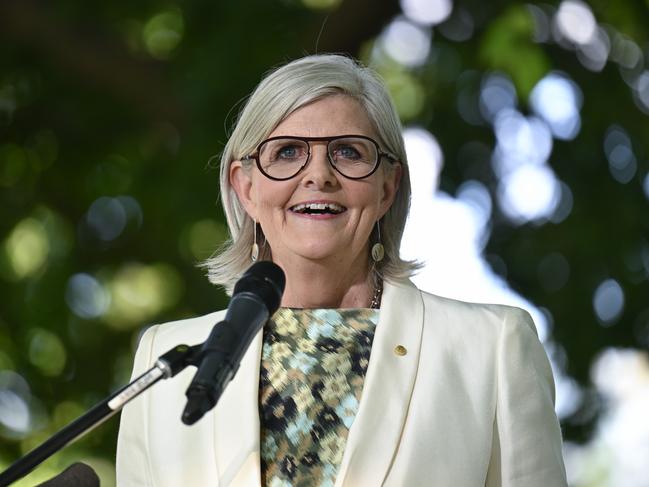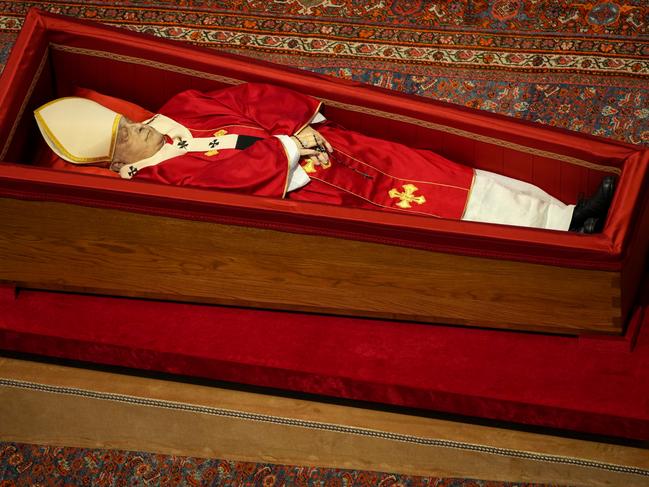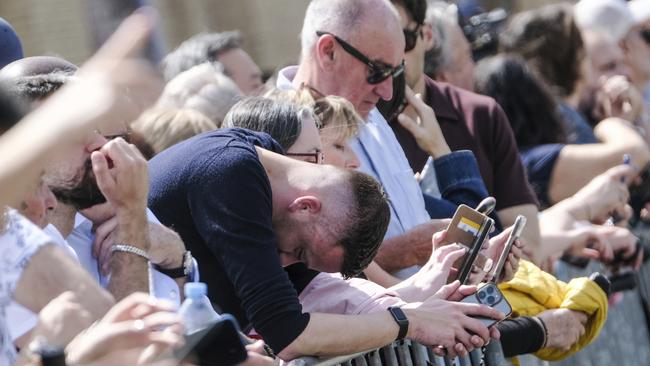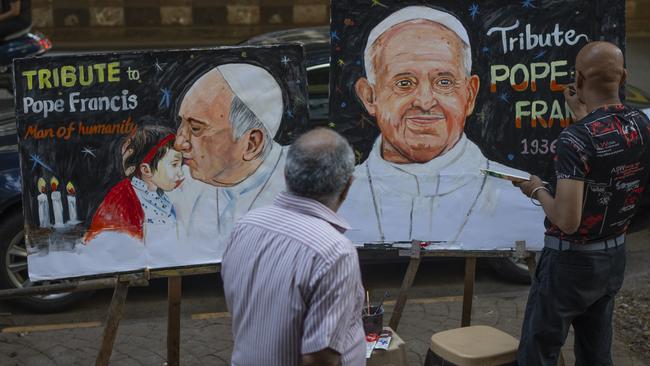What happens next: Pope Francis’ funeral, burial and conclave
As the world mourns Pope Francis, we take a look at how his funeral will unfold, where he’ll be buried, who’s vying for the top job and what the pontiff’s death means for the Catholic Church.
Europe
Don't miss out on the headlines from Europe. Followed categories will be added to My News.
As the world mourns Pope Francis, we take a look at where and when the funeral will be, who’s attending, how the next pontiff will be chosen (and who the leading candidates are) and why this is a “crossroads” moment for the Catholic Church.
WHEN AND WHERE IS THE POPE’S FUNERAL BEING HELD?
The Pope’s funeral will be held on Saturday at the front of St Peter’s Basilica, starting at 10am local time (6pm AEST). The service, which will be led by the dean of the College of Cardinals, Giovanni Battista Re, is expected to last about two and a half hours. Afterwards the Pope’s body will be moved from the Vatican through Rome to the Basilica of Santa Maria Maggiore, one of the city’s oldest and most revered churches. Francis wished to be buried in a simple underground tomb.

WHAT DIGNITARIES ARE ATTENDING?
A large array of world leaders, cardinals and many thousands of worshippers are expected to attend the funeral. Some of the high profile names attending are:
•Prince William
•US President Donald Trump
•Spain’s King Felipe VI and Queen Letizia
•Belgium’s King Philippe and Queen Mathilde
•Monaco’s Prince Albert II and Princess Charlene
•United Nations Secretary-General Antonio Guterres
•European Union Commission chief Ursula von der Leyen
•French President Emmanuel Macron
•Ukrainian President Volodymyr Zelensky
•German Chancellor Olaf Scholz
•British Prime Minister Sir Keir Starmer
•New Zealand Prime Minister Christopher Luxon
•Javier Milei, president of Argentina, where Francis was born
WHO IS REPRESENTING AUSTRALIA AT THE FUNERAL?
Australian Governor-General Sam Mostyn will travel from Turkiye where she has been commemorating Anzac Day to represent Australia at the pope’s funeral. She will be accompanied by Trade Minister Don Farrell and Nationals MP Michael McCormack.

HOW WILL THE FUNERAL UNFOLD?
The Vatican confirmed that Francis’ funeral will be held mostly outside in St Peter’s Square. Rome has enjoyed glorious weather for much of the week, and more blue skies are forecast for Saturday.
Previous papal funerals have also been held outside, with thousands of the faithful filling the open space in front of the basilica.
Although the bulk of the service will be held outside, Francis’ coffin will be brought back into the basilica after the Eucharist, final commendation and valediction.
Francis’ funeral liturgy will be presided over by Cardinal Giovanni Battista Re, dean of the College of Cardinals – the group that will in the coming weeks be tasked with appointing a new pope.
After the Mass, Francis’ body will be interred in the Papal Basilica of Santa Maria Maggiore in Rome.
WHERE WILL THE POPE BE BURIED?
Francis’ body will be interred in the Papal Basilica of Santa Maria Maggiore in Rome where seven other popes are buried. The pontiff stated in his will that he wanted his “last earthly journey to end at this very ancient Marian shrine” and he requested a simple, undecorated tomb. “The tomb should be in the ground; simple, without particular ornamentation,” he wrote.

Francis also said that throughout his life, he had always entrusted himself to the Virgin Mary. “For this reason, I ask that my mortal remains rest – awaiting the day of the Resurrection – in the Papal Basilica of Saint Mary Major,” he said.
This basilica lies outside of the Vatican walls, on the other side of Rome’s River Tiber. The 266th Pope requested a simple, undecorated tomb with only the inscription “Franciscus,” the Vatican said.
HOW MANY PEOPLE GLOBALLY ARE EXPECTED TO TUNE INTO HIS FUNERAL?
Pope Francis’ funeral is expected to draw a massive international TV audience on Saturday with pundits expecting it to top the one billion-plus mark. On the ground, at least 250,000 people are expected to attend the funeral as tens of thousands have already descended on Vatican City over the last few days to pay their respects.
WHAT WILL FRANCIS BE REMEMBERED FOR?
Pope Francis will be remembered as the Catholic Church’s most progressive pope. He was also revered for his humility, his focus on social justice, and his desire to modernise the church. He held progressive views on issues such as poverty, refugees, and climate change while he also met with LGBTQ+ groups. Tellingly, Francis also offered historic apologies to survivors of clergy sexual abuse, marking a significant step in addressing a major crisis within the church.
He also made history as the first Jesuit pope and the first non-European pope in hundreds of years.

HOW AND WHEN WILL THE NEXT POPE BE SELECTED?
The new pope will be selected via a millennia-old process – a conclave – which is expected to begin in the Sistine Chapel sometime between May 6-12, between 15-20 days after Francis’ death.
The name comes from the Latin cum clave, meaning “with key”, indicating the closed process of electing a pope.
Cardinals – senior church officials appointed by the Pope – from around the world will congregate for the conclave in which Francis’ successor will be selected.
There are more than 250 cardinals from more than 90 countries, but only about 135 are cardinal electors (those over the age of 80 are excluded). About 110 of the cardinal electors have been chosen by Francis in the past 10 years and largely reflect his vision of a more inclusive church.
Votes are taken each day, morning and afternoon, until a candidate wins a two-thirds majority. There is a day’s break for prayer and reflection after every seven ballots.
After each round of voting, the ballot cards are burned. Chemicals are added to make the smoke black or white. Black smoke emerging from the 18-metre chimney indicates an inconclusive ballot; white smoke announces to the world that a new pope has been elected.
The conclave that elected Francis in 2013 took just over 24 hours while the longest papal conclave in recent history was 1922, when the cardinals took five days to choose their new leader.
WHO IS THE NEXT FRONTRUNNER AND WHY?
Picking a pope in advance is not cut and dried. We only need to look back at the most recent conclave in 2013, when Cardinal Jorge Bergoglio was far from the favourite to succeed Pope Benedict XVI. Yet he became Pope Francis after 24 hours and five rounds of voting.
This time around, there are a number of frontrunners vying for the top job.
One of Francis’ inner circle, Luis Antonio Tagle from the Philippines, is considered a frontrunner.
The liberal 67-year-old Tagle is seen as a strong contender to continue Francis’s progressive agenda and his Asian heritage also makes him a fascinating choice, as Catholicism is growing rapidly in Asia, particularly in the Philippines.
Italian Cardinal Pietro Parolin, also considered liberal, is one of the most experienced Vatican officials. In his role as the Vatican’s Secretary of State since 2013, the 70 year old has played a major part in diplomatic affairs, including sensitive negotiations with China and Middle Eastern governments.
More conservative frontrunners are Peter Erdo from Hungary, Angelo Scola from Italy, Robert Sarah from Guinea and the fabulously titled Pierbattista Pizzaballa, an Italian Cardinal who’s been based in Jerusalem since 1990 who has significant experience in the Middle East, which is seen as a plus.
HOW SIGNIFICANT IS THIS MOMENT FOR THE CATHOLIC CHURCH?
Pope Francis’ death is being viewed as a “crossroads moment” for the Catholic Church with Vatican experts suggesting it presents the opportunity for the Church to choose a new direction, potentially moving away from some of the more inclusive and progressive directions of Francis.
Two of the main contenders to replace Francis – Cardinal Luis Antonio Tagle and Cardinal Pietro Parolin from Italy – are both considered liberal while two other favourites, Peter Erdo, and Robert Sarah are staunch conservatives, so the vote will determine the direction of the church over the coming decade.
WHERE IS THE CATHOLIC CHURCH’S NEW CENTRE?
The next leader of the Catholic Church will inherit a community that is “more culturally diverse than ever before but less European”, experts say.
Africa is now the global centre of Catholicism as demographic and generational changes have shifted the religion from its traditional European stronghold.
Vatican statistics show Europe as the only region where the religion is shrinking, while Africa is experiencing the highest Catholic population growth.
Sociology lecturer Ibrahim Abraham said this was because “a lot of the growth of any religion is just demographics”.
“It’s just how many kids are being born. Fertility is declining all around the world, less so in west Africa, so that’s where you’re starting to see a lot of that disproportionate growth of Catholicism,” he said.

The global shift of the religion has also been accelerated by Pope Francis’s leadership, as the pontiff appointed an unprecedented number of cardinals and leaders from the global south.
The decline of Catholicism in Europe is also a generational shift, as a move away from institutional affiliation and unprecedented affluence has led to religious faith not being passed down by an ageing population.
Australian Catholic University theologian Joel Hodge said for many in the western world, “you don’t need community as much when you’re so affluent, and you don’t necessarily need God as much.”

Western populations tended to be more individualistic, Mr Hodge said, while the non-western world was “much more communitarian, more traditional in some ways, more open to the transcendent and to the spiritual”.
The Catholic Church’s sexual abuse crisis and cover up also led to “increasing distrust” in the institution, Mr Hodge said.
“There was already a lot of disaffiliation in the community occurring by the time that these despicable crimes were being revealed,” he said.
“ It accelerated pre-existing trends, it was still very confronting and unexpected for a lot of people.”
Originally published as What happens next: Pope Francis’ funeral, burial and conclave


